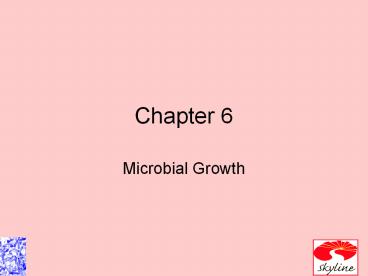Microbial Growth - PowerPoint PPT Presentation
Title:
Microbial Growth
Description:
Chapter 6 Microbial Growth What are Populations Colonies What are Populations Colonies Deep-freezing: -50 to -95 C Lyophilization (freeze-drying): Frozen (-54 to ... – PowerPoint PPT presentation
Number of Views:273
Avg rating:3.0/5.0
Title: Microbial Growth
1
Chapter 6
- Microbial Growth
2
- Microbial growth increase in number of cells,
not cell size
3
What are
- Populations
- Colonies
4
The Requirements for Growth
- Physical requirements
- Temperature
- pH
- Osmotic pressure
- Chemical requirements
- Carbon
- Nitrogen, sulfur, and phosphorous
- Trace elements
- Oxygen
- Organic growth factor
5
The Requirements for Growth Physical Requirements
- Temperature
- Minimum growth temperature
- Optimum growth temperature
- Maximum growth temperature
6
Temperature
Figure 6.1
7
Psychrotrophs
- Grow between 0C and 20-30C
- Cause food spoilage
8
Psychrotrophs
Figure 6.2
9
The Requirements for Growth Physical Requirements
- pH
- Most bacteria grow between pH 6.5 and 7.5
- Molds and yeasts grow between pH 5 and 6
- Acidophiles grow in acidic environments
10
The Requirements for Growth Physical Requirements
- Osmotic Pressure
- Hypertonic environments, increase salt or sugar,
cause plasmolysis - Extreme or obligate halophiles require high
osmotic pressure - Facultative halophiles tolerate high osmotic
pressure
11
The Requirements for Growth Physical Requirements
Figure 6.4
12
The Requirements for Growth Chemical Requirements
- Carbon
- Structural organic molecules, energy source
- Chemoheterotrophs use organic carbon sources
- Autotrophs use CO2
13
- Nitrogen
- In amino acids, proteins
- Most bacteria decompose proteins
- Some bacteria use NH4 or NO3?
- A few bacteria use N2 in nitrogen fixation
- Sulfur
- In amino acids, thiamine, biotin
- Most bacteria decompose proteins
- Some bacteria use SO42? or H2S
- Phosphorus
- In DNA, RNA, ATP, and membranes
- PO43? is a source of phosphorus
14
- Trace Elements
- Inorganic elements required in small amounts
- Usually as enzyme cofactors
15
- Oxygen (O2)
Obligate aerobes Faultative anaerobes Obligate anaerobes Aerotolerant anaerobes Microaerophiles
16
Toxic Forms of Oxygen
- Singlet oxygen O2 boosted to a higher-energy
state - Superoxide free radicals O2?
- Peroxide anion O22?
- Hydroxyl radical (OH?)
17
Biofilms
- Microbial communities
- Form slime or hydrogels
- Bacteria attracted by chemicals via quorum
sensing
Figure 6.5
18
The Requirements for Growth Chemical Requirements
- Organic Growth Factors
- Organic compounds obtained from the environment
- Vitamins, amino acids, purines, pyrimidines
19
Culture Media
- Culture Medium Nutrients prepared for microbial
growth - Sterile No living microbes
- Inoculum Introduction of microbes into medium
- Culture Microbes growing in/on culture medium
20
Agar
- Complex polysaccharide
- Used as solidifying agent for culture media in
Petri plates, slants, and deeps - Generally not metabolized by microbes
- Liquefies at 100C
- Solidifies 40C
21
Culture Media
- Chemically Defined Media Exact chemical
composition is known - Complex Media Extracts and digests of yeasts,
meat, or plants - Nutrient broth
- Nutrient agar
22
Culture Media
Table 6.2 6.4
23
Anaerobic Culture Methods
- Reducing media
- Contain chemicals (thioglycollate or oxyrase)
that combine O2 - Heated to drive off O2
24
An Anaerobic Chamber
Figure 6.7
25
Anaerobic Culture Methods
- Anaerobic jar
Figure 6.5
26
Capnophiles require high CO2
- Candle jar
- CO2-packet
Figure 6.7
27
Biosafety Levels
- 1 No special precautions
- 2 Lab coat, gloves, eye protection
- 3 Biosafety cabinets to prevent airborne
transmission - 4 Sealed, negative pressure
- Exhaust air is filtered twice
28
Biosafety Level 4 (BSL-4) Laboratory
Figure 6.8
29
Selective Media
- Suppress unwanted microbes and encourage desired
microbes.
Figure 6.9b, c
30
Differential Media
- Make it easy to distinguish colonies of different
microbes.
Figure 6.9a
31
Enrichment Media
- Encourages growth of desired microbe
- Assume a soil sample contains a few
phenol-degrading bacteria and thousands of other
bacteria - Inoculate phenol-containing culture medium with
the soil and incubate - Transfer 1 ml to another flask of the phenol
medium and incubate - Transfer 1 ml to another flask of the phenol
medium and incubate - Only phenol-metabolizing bacteria will be growing
32
- A pure culture contains only one species or
strain - A colony is a population of cells arising from a
single cell or spore or from a group of attached
cells - A colony is often called a colony-forming unit
(CFU)
33
Streak Plate
Figure 6.10a, b
34
Preserving Bacteria Cultures
- Deep-freezing -50to -95C
- Lyophilization (freeze-drying) Frozen (-54 to
-72C) and dehydrated in a vacuum
35
Reproduction in Prokaryotes
- Binary fission
- Budding
- Conidiospores (actinomycetes)
- Fragmentation of filaments
36
Binary Fission
Figure 6.11
37
Figure 6.12b
38
- If 100 cells growing for 5 hours produced
1,720,320 cells
39
Figure 6.13
40
Phases of Growth
ANIMATION Bacterial Growth Curve
Figure 6.15
41
Direct Measurements of Microbial Growth
- Plate Counts Perform serial dilutions of a sample
Figure 6.15, top portion
42
Plate Count
- Inoculate Petri plates from serial dilutions
Figure 6.16
43
Plate Count
- After incubation, count colonies on plates that
have 25-250 colonies (CFUs)
Figure 6.15
44
Direct Measurements of Microbial Growth
- Filtration
Figure 6.17a, b
45
Direct Measurements of Microbial Growth
- Multiple tube MPN test
- Count positive tubes and compare to statistical
MPN table.
Figure 6.18b
46
Direct Measurements of Microbial Growth
- Direct Microscopic Count
47
Direct Measurements of Microbial Growth
Figure 6.19
48
Estimating Bacterial Numbers by Indirect Methods
- Turbidity
Figure 620
49
Estimating Bacterial Numbers by Indirect methods
- Metabolic activity
- Dry weight

